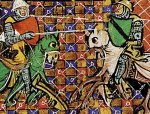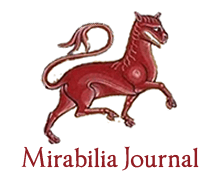Issue
-
The chivalry and the art of war in the Ancient and Medieval World
A cavalaria e a arte da guerra no Mundo Antigo e Medieval
Organized by José Enrique RUIZ-DOMÈNEC e Ricardo da COSTA (orgs.)
Mirabilia 08 (2008)

Article
-
Symbol and visionary experience in Hildegard of Bingen’s Epistolary (1098-1179)
María ESTHER ORTIZ
Original title: Símbolo y experiencia visionaria en el Epistolario de Hildegarda de Bingen (1098-1179)
Published in The Medieval Aesthetics
Hildegard of Bingen’s epistolary gathers, in its almost four hundred letters, a very rich biographic material with XII century historic and cultural data. It also presents a particular style, closed related to her visionary gift. Inside the exploration of this mundus imaginalis, a real aesthetic experience takes place: the symbols constellations that appear in these texts (mainly from nature) correspond with similar images from other languages used by Hildegard such as pictorial and musical ones. By means of some examples, this article inquires to what extent and in which way this perspective broadens the hermeneutic horizon in the epistolary texts.
-
La poétique du corps: expressions et gestes dans le Retable de Saint Jean-Baptiste (1425-1430) de Bernat Martorell (1390-1452)
Matheus Corassa da SILVA, Ricardo da COSTA
Original title: A poética do corpo: expressões e gestos no Retábulo de São João Batista (1425-1430) de Bernat Martorell (1390-1452)
Published in Ramon Llull. Seventh centenary
Ce travail a l’intention de réaliser une étude iconographique du Retable de Saint Jean-Baptiste (1425-1430), attribué au peintre gothique catalan Bernat Martorell (1390-1452), afin d’analyser les représentations imagétiques du corps du saint, ses expressions faciales, ses gestes. Entre la vie d’ermite et la décapitation. Nous aurons, d’abord, une brève contextualisation du thème afin de situer les approches historiques, artistiques et philosophiques sur le corps, en particulier dans le Moyen Âge, notre époque d’étude. Après, nous présentons quelques informations sur l’histoire, l’emplacement et la division des compartiments de ce retable, le plus ancien attribué à Martorell. Nous procéderons, enfin, par l’analyse iconographique de deux des compartiments du retable: le central et ce qui représente la décollation du saint ermite. Nous suivons donc la proposition méthodologique de Erwin Panofsky (1892-1968), associée avec la hiérarchie analytique de Jean-Claude Schmitt (1946-).
-
Linguistic and Cultural Studies on Curial e Güelfa, a 15th Century Anonymous Chivalric Romance in Catalan
Matheus Corassa da SILVA and Ricardo da COSTA
Original title: Estudis lingüístics i culturals sobre Curial e Güelfa. Novella cavalleresca anònima del segle XV en llengua catalana'
Published in Emotions in the Ancient and Medieval Mediterranean World
-
Echoes of “Perceval ou le Conte du Graal” (c. 1182-1190) by Chrétien de Troyes in the work of Rubén Darío (1867-1916)
Antonia Javiera CABRERA MUÑOZ
Original title: Ecos de “Perceval ou le Conte du Graal” (c. 1182-1190) de Chrétien de Troyes en la obra de Rubén Darío (1867-1916)
Published in Languages and Cultures in Tradition
Throughout history, the myth of King Arthur and the Knights of the Round Table has been conceived as a model, an ideal of human action. They are the model of perfect conduct that transcends time: we first hear of this myth in Chrétien de Troyes, in the 12th century, in the unfinished work “Perceval ou le Conte du Graal” (c.1182-1190), translated into Spanish by Martín de Riquer as “Perceval o el Cuento del Grial” (1961). In Spanish-American literature, the Nicaraguan poet Rubén Darío (1867-1916) published several works in which the medieval is present in poetry and prose, such as in the short story “A las orillas del Rhin”, published in serial form in the magazine “El Porvenir” de Nicaragua on 14 July 1885. In poetry, we have more references to medieval characters, such as “Percival and Lohengrin”. In Troyes’ version, Percival admits his mistakes and returns to complete his quest for the Holy Grail. In Darío, similarly, we have an erratic Percival, characterised as “el loco luminoso” (“the luminous madman”), which leads us to believe that there is a possible intertextual relationship between these works. We ask ourselves: what is the influence of this archetypal character in Darío’s poetry, which, like Troyes, portrays him as a buffoon or a clumsy character according to Mircea Eliade’s reading (1938), and which may have possible connections with the character of “Don Quixote”, the Knight of the Sad Countenance? The aim is to bring the myth closer to the literature of the two authors in question, based on the notion of myth as a human archetype.
-
Esse, Intelligere et Vivere in the thought of Meister Eckhart (1260-1328)
Matteo RASCHIETTI
Original title: Esse, Intelligere et Vivere no pensamento de Meister Eckhart (1260-1328)
Published in Languages and Cultures in Tradition
This article examines the central role of the concepts esse, intelligere, and vivere in Meister Eckhart’s thought. Starting from his ontology of esse, which identifies God as being itself and the foundation of all things, the study explores how Eckhart articulates this perspective with the primacy of intelligere, understood as the divine intellect and the very ground of being. The analysis highlights his departure from Thomistic metaphysics and from the Exodus tradition, by affirming that God is not primarily ens but intellect and knowledge. Finally, the article addresses the notion of vivere as fullness of life, manifested in the union of the soul with the eternal Logos. Thus, it becomes evident that, for Eckhart, the human spiritual journey consists in transcending the realm of created being to partake in divine life, where intellect and the inner word become the place of God’s birth within the soul.
-
Between Nature and Grace: Christian Corporeality in “The Book of Contemplation in God” (1271-1274) by Ramon Llull (1232-1315)
Ricardo da COSTA; Gabriel Tebaldi MEIRA
Original title: Entre a Natureza e a Graça: a corporeidade cristã no “Livro da Contemplação em Deus” (1271-1274) de Ramon Llull (1232-1315)
Published in Languages and Cultures in Tradition
This article investigates the conception of Christian corporeality in Ramon Llull’s (1232-1315) “The Book of Contemplation in God” (1271-1274), examining how the author integrates the classical philosophical tradition – especially Plato, Aristotle and Plotinus – with Christian Theology and medieval Scholasticism. Drawing on the doctrine of human powers and the physical-spiritual structure of man, Llull presents the body as a reflection of the divine order, an instrument of the soul, and a means of moral asceticism. The study analyses the relationship between nature and grace in Llull’s thought, demonstrating that the body, far from being a mere receptacle of the soul, constitutes a space of revelation and communion with God. Through the harmonization of the four elements, the five senses, and the vegetative, sensitive, imaginative, rational, and motor powers, Llull proposes an integrated vision of human existence, in which bodily and spiritual life converge toward the contemplation and praise of the Creator.
-
The War of Granada: Translation from Latin into Spanish and English and Study of Historical Fragments by Elio Antonio de Nebrija (1444-1522)
Enric MALLORQUÍ-RUSCALLEDA
Original title: La Guerra de Granada: traducción del latín al español e inglés y estudio de fragmentos históricos de Elio Antonio de Nebrija (1444-1522)
Published in Intercultural Mediterranean
Language:
This paper presents a series of direct translations of Nebrija’s Latin and the edition and annotation of fragments of the historical work Guerra de Granada (De Bello Granatensi) by Elio Antonio de Nebrija. Based on the outstanding edition of the Latin text by Prof. Dr. María Luisa Arribas Hernáez, the article is addressed to scholars, students of classical philology and history, and anyone interested in the history of the Reconquista and medieval literature. This first instalment of what is expected to be a complete translation of Nebrija’s text in both English and Spanish offers an invaluable tool for researching and studying this text published in 1545. In addition to improving the Spanish translation and creating an English version, cultural notes have been included to enrich the understanding of the text.
-
Mediterranean Cultural Tensions in Roman Egypt in light of the Λόγος Τέλειος (III AD)
David Pessoa de LIRA
Original title: Tensões mediterrâneas culturais no Egito Romano à Luz do Λόγος Τέλειος (III AD)
Published in Intercultural Mediterranean
Language:
The Mediterranean in the Ancient Age was a space of conflicts, exchanges, encounters, interactions and disagreements. This article examines the cultural tensions between native Egyptians (ⲛ̅ⲣⲙ̅ⲛ̅ⲕⲏⲙⲉ [enremenkēme]) and the settlers of the metropolitan nomos in Roman Egypt, known as ἀλλόφυλοι or ⲛⲁⲗⲗⲟⲫⲩⲗⲟⲥ [n.allophylos], from a historical-literary and cultural perspective. The study focuses on the predictions of the Λόγος Τέλειος, corresponding to Asclepius 24 in its Latin version and ⲗⲟⲅⲟⲥ ⲧⲉⲗⲉⲓⲟⲥ (Nag Hammadi VI.8 [70.3-71.29]) in its Coptic version, with particular emphasis on sociocultural interaction in Roman Egypt.


















































































